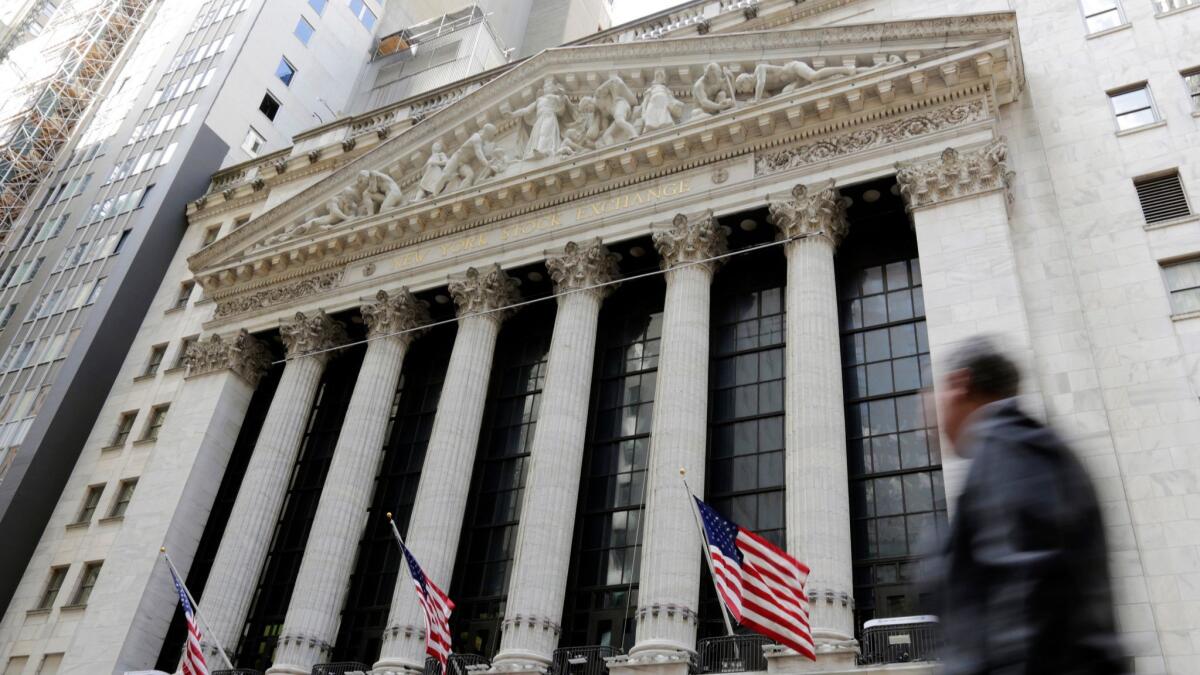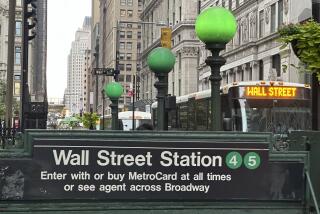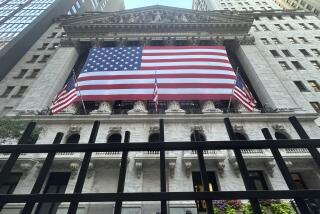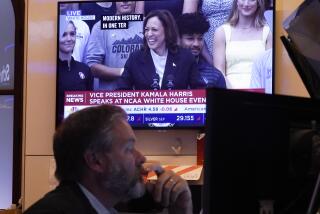Stocks edge up, ending the second quarter with small gains

U.S. stocks finished mostly higher Friday, but they surrendered most of an early gain as worries about rising tariffs once again dampened investors’ enthusiasm as the second quarter came to an end.
Bank shares rose after the Federal Reserve allowed most of the largest financial institutions in the U.S. to pay bigger dividends to shareholders and buy back tens of billions of dollars’ worth of stock. Wells Fargo made its biggest gain since shortly after the 2016 presidential election. Nike had its biggest surge in almost four years after it said sales in North America improved in its latest quarter.
The Commerce Department said spending by consumers rose a disappointing 0.2% in May. But wages continued to improve, and Shawn Cruz, manager of trader strategy for TD Ameritrade, said that suggests spending will rise.
“Investors wanted to see what the potential is for consumer spending in the future,” Cruz said. “Wage growth came in solid enough that there wasn’t a major concern.”
The Standard & Poor’s 500 index edged up 2.06 points, or 0.1%, to 2,718.37. The Dow Jones industrial average rose 55.36 points, or 0.2%, to 24,271.41. The Nasdaq composite rose 6.62 points, or 0.1%, to 7,510.30. The Russell 2000 index of smaller-company stocks slipped 1.95 points, or 0.1%, to 1,643.07.
Earlier in the day, the Dow was up as much as 293 points, but those gains eroded as investors again focused on the trade concerns that have rocked the market since late February. Canada announced $12.6 billion in retaliatory tariffs on U.S. goods in response to the U.S. tariffs on steel and aluminum imports. General Motors warned that if the Trump administration places import taxes on cars and car parts, it probably will face retaliation and might have to eliminate U.S. jobs.
The Federal Reserve allowed 32 of the 35 largest banks in the U.S. to raise their quarterly dividends and buy back more stock. The central bank determined that those institutions are in good enough financial shape to weather a major downturn in the economy.
Wells Fargo climbed 3.4% to $55.44. Although the Federal Reserve’s “stress tests” measure a bank’s financial health and are separate from its business tactics, investors felt the Fed’s approval was a notable win for Wells Fargo. Earlier this year, the Fed ordered the bank to replace several of its directors and limited its growth in response to abusive practices including opening accounts in customers’ names without those customers’ knowledge or permission — actions that duped consumers out of millions of dollars. Wells Fargo admitted to those practices in 2016 and has since agreed to pay more than $1.5 billion in fines, penalties and legal settlements.
Nike jumped 11.1% to $79.68 after it said its revenue in North America grew after several quarters of declines, and its fourth-quarter profit and sales blew past Wall Street forecasts. The athletic apparel company also said it will buy back $15 billion in stock over the next four years.
With trade tensions in focus throughout the second quarter, stocks didn’t make big gains after a very strong round of first-quarter corporate reports. The S&P 500 rose 2.9% over those three months, and the Dow rose just 0.7%.
Investors felt technology companies and smaller, more U.S.-focused companies were safe picks in case the trade tensions get worse. The Nasdaq composite jumped 6.3%, and the Russell 2000 index advanced 7.4%. Both set records as recently as last week.
Only a week remains before the U.S. and China each plan to place tariffs on tens of billions of dollars in imports from the other. Cruz, of TD Ameritrade, said the outcome of the broader trade tensions will help determine what stocks do in the months to come: He said stocks might set more records if the situation is resolved in a way the market likes, but if the tensions end up hurting global economic growth, stocks could fall further.
KB Home climbed 7.3% to $27.24 after the homebuilder posted a larger profit and better sales than expected.
Synnex fell 9.6% to $96.51 after the high-tech contractor agreed to buy customer management company Convergys in a deal the companies valued at $2.8 billion. Convergys fell 3.7% to $24.44.
Energy companies and oil prices continued to climb. Benchmark U.S. crude rose 1% to $74.15 a barrel in New York to its highest price since late 2014. It climbed 14% during the second quarter.
The S&P 500 index of energy companies climbed almost 13% during the quarter, far better than the rest of the market and its biggest gain in 6 1/2 years.
Brent crude, used to price international oils, rose 1.9% to $79.44 a barrel in London.
Wholesale gasoline climbed 2.2% to $2.18 a gallon. Heating oil jumped 1.4% to $2.21 a gallon. Natural gas fell 0.5% to $2.92 per 1,000 cubic feet.
Bond prices wobbled and turned lower. The yield on the 10-year Treasury note rose to 2.86%, from 2.84%.
Gold rose 0.3% to $1,254.50 an ounce. Silver rose 1% to $16.20 an ounce. Copper fell 0.2% to $2.97 a pound.
The dollar rose to 110.85 yen, from 110.64 yen. The euro rose to $1.1672, from $1.1555.
France’s CAC 40 gained 0.9% and the German DAX climbed 1.1% after a deal on migration relieved pressure on the coalition government of German Chancellor Angela Merkel. Britain’s FTSE 100 rose 0.3%.
Japan’s benchmark Nikkei 225 edged up 0.2%. South Korea’s Kospi advanced 0.5%. Hong Kong’s Hang Seng gained 1.6%.
UPDATES:
2:20 p.m.: This article was updated with closing prices, context and analyst comment.
1:25 p.m.: This article was updated with the close of markets.
9:20 a.m.: This article was updated with market prices and context.
This article was originally published at 7:05 a.m.
More to Read
Inside the business of entertainment
The Wide Shot brings you news, analysis and insights on everything from streaming wars to production — and what it all means for the future.
You may occasionally receive promotional content from the Los Angeles Times.










